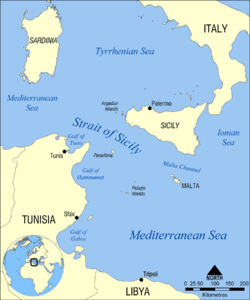Operation Retribution facts for kids
Quick facts for kids Operation Retribution |
|||||||
|---|---|---|---|---|---|---|---|
| Part of the Tunisia Campaign of the Second World War | |||||||
 The Strait of Sicily and surrounding waters |
|||||||
|
|||||||
| Belligerents | |||||||
| Commanders and leaders | |||||||
| Unknown | |||||||
Operation Retribution was an important event during World War II. It was a plan by the Allies (like Britain and the United States) to stop Axis soldiers (from Germany and Italy) from escaping by sea. These Axis soldiers were stuck in Tunisia, a country in North Africa. The Allies wanted to make sure no enemy soldiers could get away to Sicily, an island near Italy.
This operation was a "blockade." A blockade means stopping things from moving in or out of an area. In this case, it was a naval (sea) and air blockade. The goal was to trap the Axis forces in Tunisia. Another operation, called Operation Flax, did the same thing for air escapes.
British Admiral Andrew Cunningham led the naval part of this operation. He started it on May 7, 1943. He sent a famous message to his ships: "Sink, burn and destroy. Let nothing pass." Admiral Cunningham named the operation "Retribution" because he wanted to get back at the Germans. His ships had suffered many losses during the German invasions of Greece and Crete.
Stopping the Escape
The Allies knew the Axis forces were in trouble in Tunisia. They expected the Axis to try a huge escape by sea. To stop this, the Allies gathered all their smaller warships. These ships went to Malta or Bone (a port city). They were given specific areas to patrol.
To make sure enough ships were available, the Allies even stopped some of their own supply convoys. This allowed the escort ships to join the blockade. The Allies also thought the Italian Navy might try to help the Axis escape. So, big warships like the battleships HMS Nelson and Rodney, and the aircraft carrier HMS Formidable, moved to Algiers. They were ready for a major battle if the Italian fleet showed up.
No Escape by Sea
In the end, the Italian Navy did not leave their ports. They knew the British Navy was very strong in the Mediterranean Sea. So, there was no big attempt by the Axis to escape by sea. Only two supply ships heading to Tunisia were found and sunk by the Allies.
Smaller Allied boats, like British MTBs and American PT boats, patrolled close to the coast. They stopped small enemy boats and raided the waters near Ras Idda and Kelibia. The biggest danger to the Allied ships was actually from their own planes. Sometimes, Allied aircraft accidentally attacked Allied ships. After this, red patches were painted on the ships to help planes recognize them.
The Allies managed to capture 897 Axis soldiers during the operation. About 653 German and Italian soldiers are thought to have escaped to Italy. Sadly, an unknown number of soldiers drowned while trying to escape.
The End of the Campaign
The Axis forces in North Africa were trapped in a small area. They had very few supplies and faced strong Allied armies. Because of this, they surrendered on May 13, 1943. This marked the end of the Tunisia Campaign.
After the surrender, the ports in North Africa were quickly cleared. They were made ready to support the next big Allied plans: invading southern Europe. Special groups of ships, called minesweepers, worked hard. They cleared a path through the minefields in the Sicilian Channel all the way to Tripoli. They removed almost 200 mines that were floating or anchored in the water.
On May 15, Admiral Cunningham sent another important message. He announced that "the passage through the Mediterranean was clear." This meant that ships could now travel directly from Gibraltar to Alexandria. This direct route had been closed since May 1941. Reopening it saved a lot of time and resources for the Allies.
See also

